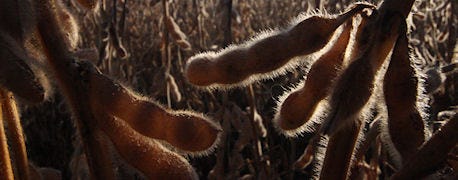September 17, 2014

By Jennifer Bradley
Harvest season is a busy time. Everyone knows that. Adding one more thing to the "to-do list" may seem like a hassle, but scouting fields while in the combine is one item that you should add to your list. It will help you plan ahead.
Vince Davis, University of Wisconsin cropping systems weed scientist and Extension specialist, says that while many farmers make mental notes of the weeds they see from their combine seats, not enough are writing the information down in a map for next season's planning.
"I think we need to continue encouraging it," he says. "You can already have a plan in place to deal with those weed species."

While harvesting soybeans and corn this fall, note what types of weeds are in fields. Also, write down which ones have gone to seed. If they are seeding, plan to attack them next year.
One thing Davis recommends growers look for is what types of weeds are in fields. Also, it's important to note which ones have gone to seed. If they are seeding, he says farmers can plan to attack them next year.
The timing is also important to note in regard to herbicide application. Davis explains that if weeds were sprayed and injured, but still continued to grow, evaluation must be done of their herbicide resistance.
"That's a very important to be concerned about," he adds. "Or did the weeds emerge after the control strategies were implemented in the crop -- a late season escape?"
Damon Smith, a field crops Extension pathologist at UW-Madison, says that while most diseases are past scouting at this time of year, white mold is one that farmers can be on the lookout for during harvest. He recommends that any fields infected with the disease be harvested last.
"The fungus that causes white mold produces long-living sclerotia," Smith explains. It can potentially affect other fields while being harvested.
Smith says farmers should first assess how much while mold a crop has at maturity, if any. Then, harvest the fields progressively until the most infected are last. He also recommends farmers clean out combines thoroughly.
"You want to make sure the white mold isn't retained in the combine for next season," Smith says.
Charting the pressure of white mold is another useful tool, which helps a grower make decisions for next year's planting.
The last thing to scout in the combine is insect presence. Eileen Cullen is an associate professor and Extension specialist at UW-Madison's Department of entomology. She says that a combine provides the perfect vantage point for spotting lodged corn stalks. While this can be an indication that rootworm seeding has occurred, she is also quick to point out that's definitely not the only reason corn could be found lying on the ground.
Corn rootworm, however, is a pest many farmers find themselves up against, and don't even realize until harvest.
"It's important to keep an eye out for next year," she says. "There's nothing you can do at this point, but increase awareness and have some idea what the population was this season."
Cullen explains that corn rootworm is particularly an issue with continuous corn rotation, if some type of BT crop was used, or a soil insecticide. She says she has seen some resistance to rootworm from various types of BT corn.
While a stalk down here or there is no big deal, large spots or areas down throughout the field should have samples taken. It's as easy as pulling up a few roots and asking a county Extension agent or agronomist to help identify markers of rootworm. Then, it's time to consider crop rotation, as well as rootworm practices, Cullen adds.
"Farmers may be knowledgeable about rootworm, but not realize issues with certain corn traits or insecticides until sitting up high, overlooking the fields in the fall," she says.
Whether weeds, diseases or pests, all three experts agree tracking and then mapping trends is a great tool for farmers while in the combine.
Bradley writes from Chilton.
You May Also Like




